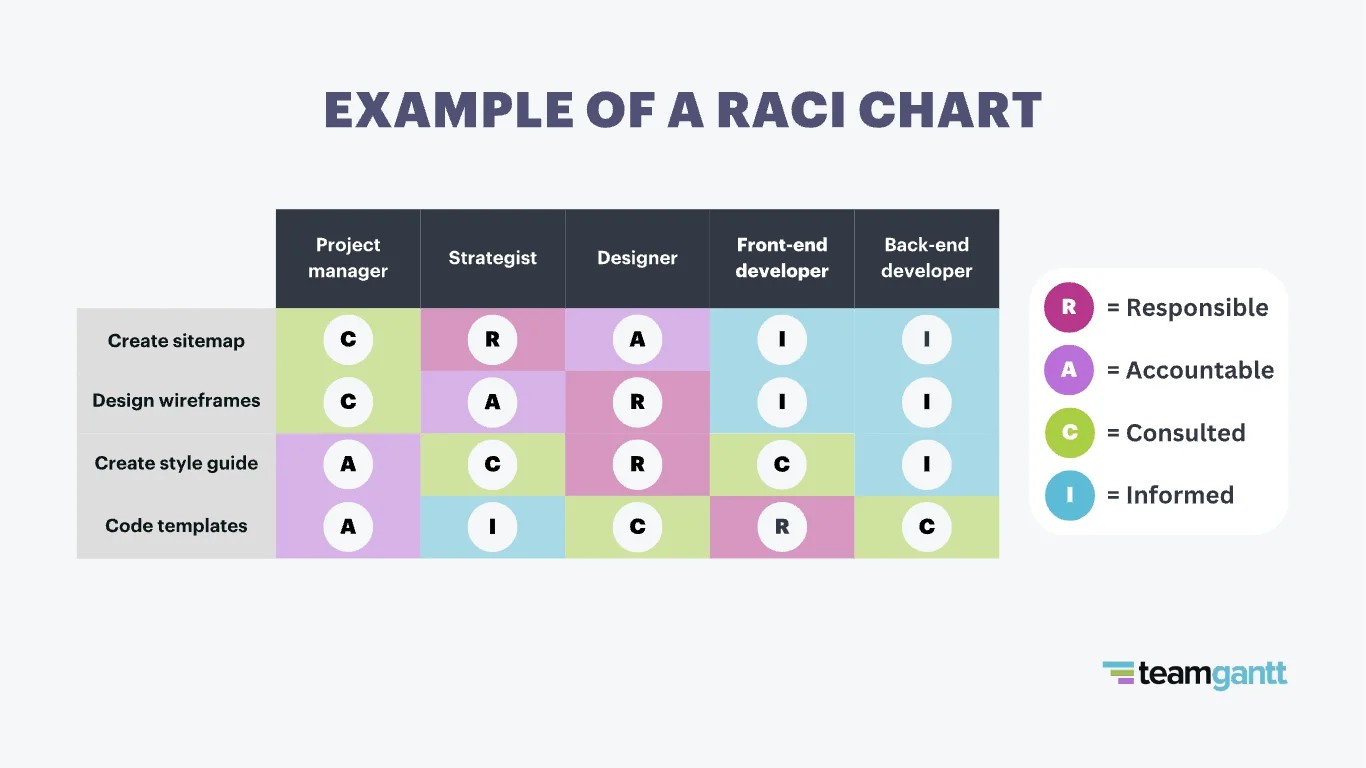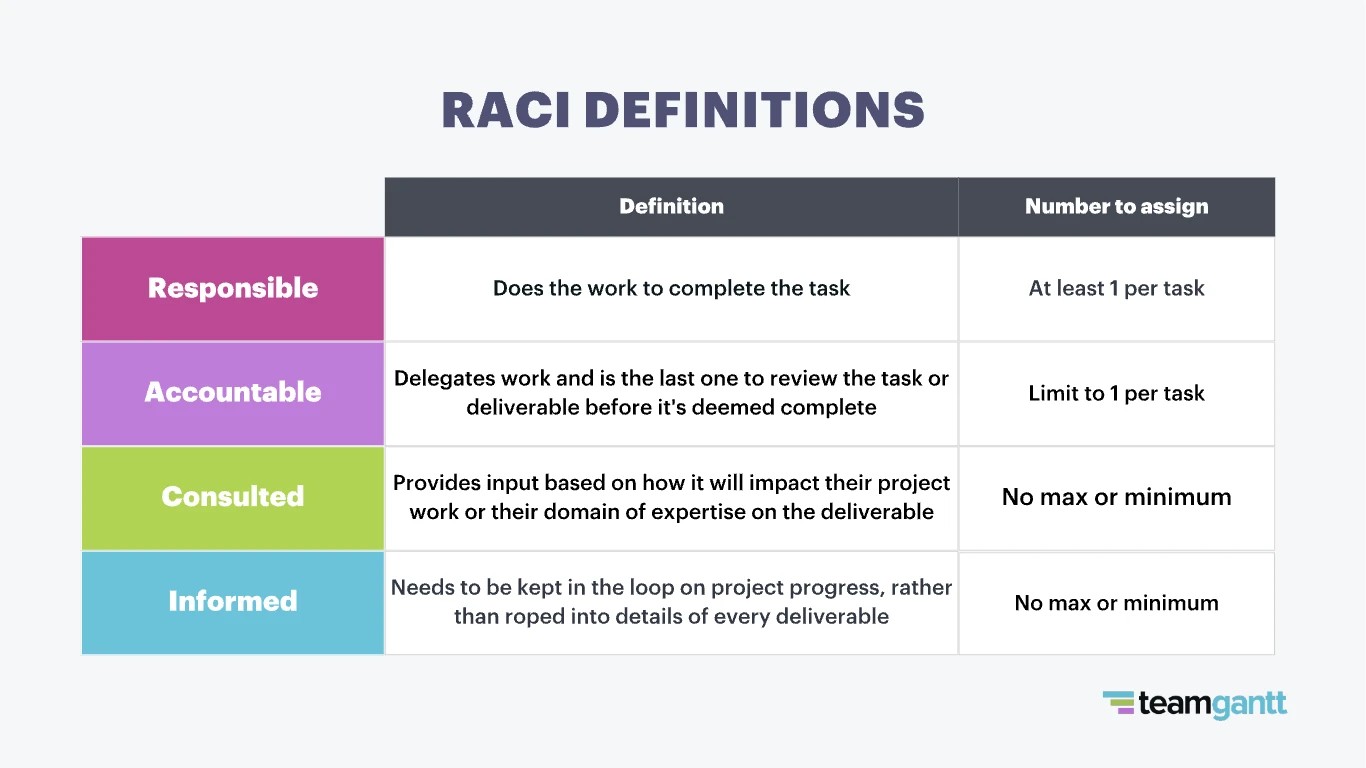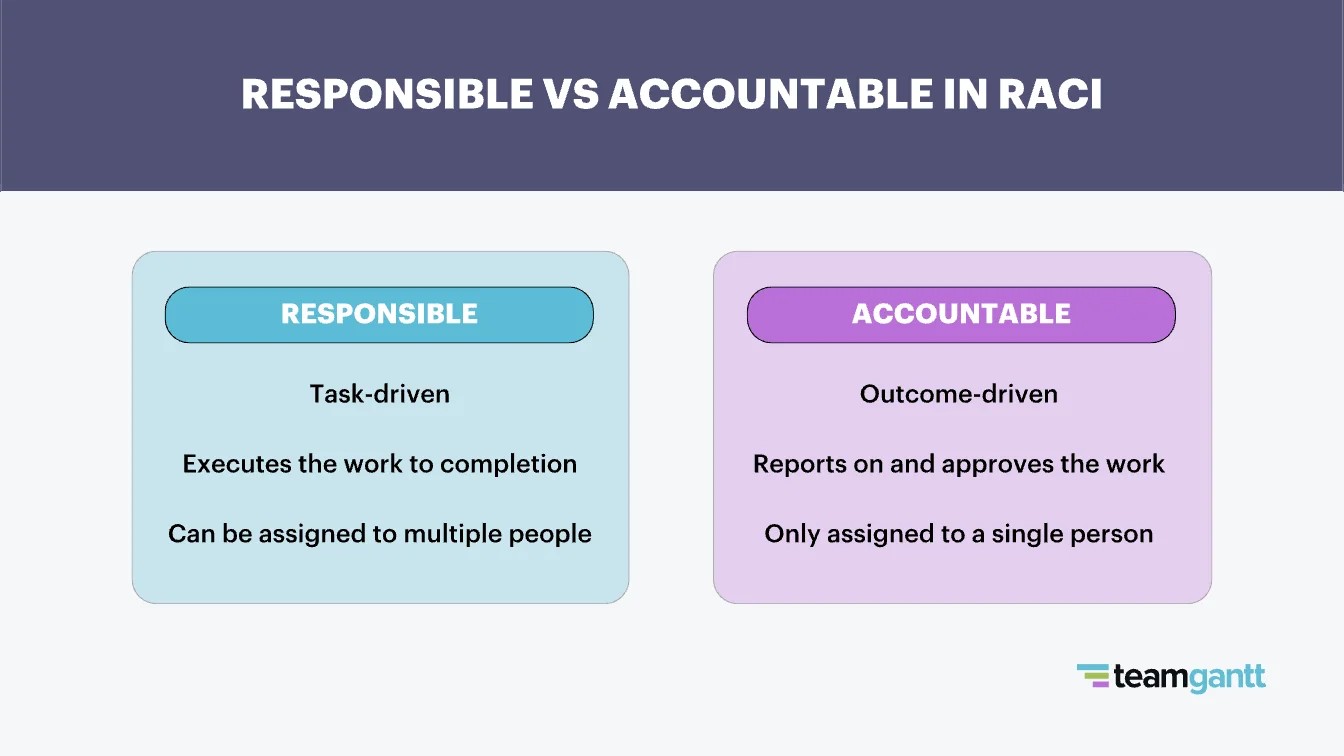What Is Raci? At WHAT.EDU.VN, we simplify project management by defining RACI as a tool to clarify roles and responsibilities. Our goal is to provide solutions that enhance team collaboration and improve task clarity. Explore our platform for free answers on project management strategies and learn how to use role assignments and responsibility matrices to boost your project outcomes.
1. Understanding the RACI Model
The RACI model, an acronym for Responsible, Accountable, Consulted, and Informed, is a powerful tool used in project management. It helps clarify roles and responsibilities for each task, milestone, or decision within a project. By defining who does the work, who makes the final call, whose input is needed, and who needs to be kept in the loop, the RACI model reduces confusion and enhances team collaboration. Let’s delve deeper into each component of RACI and understand how to apply it effectively.
1.1. Defining the RACI Components
To effectively implement the RACI model, it’s crucial to understand what each role entails. Here’s a breakdown:
-
Responsible (R): The individuals who do the work to complete the task. They are directly responsible for the execution.
-
Accountable (A): The person who is ultimately answerable for the correct and thorough completion of the task. Only one person should be accountable for each task.
-
Consulted (C): Individuals whose opinions are sought. They provide input and feedback based on their expertise.
-
Informed (I): Individuals who are kept updated on the progress and outcomes of the task. They don’t need to be actively involved but need to stay in the loop.
1.2. Differentiating Between Responsible and Accountable
It’s important to differentiate between the ‘Responsible’ and ‘Accountable’ roles. While a team can be ‘Responsible’ for executing a task, only one person should be ‘Accountable’ for its completion. The ‘Accountable’ person ensures the task meets the required standards and is ultimately responsible for the outcome. This distinction is vital for maintaining clarity and avoiding confusion.
2. The Benefits of Using a RACI Chart
Implementing a RACI chart offers numerous benefits for project management. It promotes accountability, reduces ambiguity, and ensures that all team members understand their roles. By clearly defining responsibilities, a RACI chart can significantly improve project efficiency and outcomes.
2.1. Enhancing Accountability and Clarity
A RACI chart ensures that each task has a designated owner, fostering a sense of accountability. This clarity reduces the chances of tasks falling through the cracks and ensures that everyone understands their responsibilities. This is especially important in large projects with multiple stakeholders.
2.2. Reducing Ambiguity and Overlap
Without a RACI chart, tasks may be duplicated, or individuals may be unsure of their roles. A RACI chart eliminates this ambiguity by clearly defining who is responsible for what. This reduces confusion and minimizes the potential for conflict.
2.3. Improving Project Efficiency and Outcomes
By streamlining roles and responsibilities, a RACI chart can significantly improve project efficiency. Team members can focus on their assigned tasks without worrying about overlaps or gaps, leading to better project outcomes.
3. Creating a RACI Chart: A Step-by-Step Guide
Creating a RACI chart involves a systematic approach to ensure all tasks and roles are accurately mapped. Here’s a step-by-step guide to help you create an effective RACI chart for your project.
3.1. Identifying Project Tasks and Activities
Start by listing all the key tasks and activities required to complete the project. Break down the project into manageable tasks to ensure no activity is overlooked. This list will form the rows of your RACI chart.
3.2. Identifying Project Roles and Stakeholders
Next, identify all the roles and stakeholders involved in the project. This includes team members, managers, and external parties. These roles will form the columns of your RACI chart.
3.3. Assigning RACI Roles to Each Task
For each task, assign the appropriate RACI role to each stakeholder. Determine who is Responsible, Accountable, Consulted, and Informed for each task. Ensure that each task has at least one Responsible party and only one Accountable party.
3.4. Reviewing and Validating the RACI Chart
Once the RACI chart is complete, review it with your team to ensure accuracy and completeness. Validate the assignments and make any necessary adjustments. This review process ensures that everyone understands and agrees with their assigned roles.
4. Practical Examples of RACI Charts
To illustrate how RACI charts work in practice, let’s consider two examples: producing a marketing handout and developing a new software product. These examples will help you understand how to apply the RACI model to different types of projects.
4.1. Example 1: Producing a Marketing Handout
Consider a project to produce a marketing handout for an industry conference. The tasks might include writing a project brief, creating content, designing the handout, reviewing the first draft, updating the handout, approving the final version, and sending it to the printer.
The roles involved might include the project manager, CMO, marketing manager, editorial director, content writer, creative director, and designer. The RACI chart would assign roles for each task, ensuring clarity and accountability.
4.2. Example 2: Developing a New Software Product
Developing a new software product involves various tasks such as market research, requirement gathering, design and prototyping, software development, testing, deployment, maintenance, monitoring, marketing and sales, and user training.
The roles involved might include business analysts, product managers, UI/UX designers, software architects, software developers, QA analysts, DevOps engineers, marketing managers, sales representatives, customer support specialists, and technical writers.
The RACI chart would map out the roles for each task, ensuring that everyone understands their responsibilities and how they contribute to the project.
5. When to Use or Skip a RACI Chart
While a RACI chart can be beneficial for most projects, there are situations where it may not be necessary. Consider the following guidelines to determine when to use or skip a RACI chart.
5.1. Situations Where a RACI Chart is Useful
A RACI chart is particularly useful when:
- Tasks require multiple resources.
- Tasks run concurrently.
- Tasks depend on other tasks.
- The decision-making process could hold up the project.
- There’s conflict about task ownership.
- The project workload feels unevenly distributed.
- You experience turnover on a team.
5.2. Situations Where a RACI Chart May Not Be Necessary
A RACI chart may not be necessary when:
- The team communicates effectively and stays on top of their work.
- The project is small enough that defining roles seems unnecessary.
- The project team is self-managing and requires minimal oversight.
6. Common RACI Pitfalls and How to Avoid Them
To ensure your RACI chart is effective, avoid these common pitfalls. Understanding these potential issues and how to address them will help you maximize the benefits of the RACI model.
6.1. Failing to Get Buy-In From Your Team and Stakeholders
Creating a RACI chart without input from your team and stakeholders can lead to misunderstandings and resistance. Ensure everyone acknowledges and agrees to the assigned roles. More importantly, check that your chart eliminates any further project confusion.
6.2. Setting It and Forgetting It
A RACI chart should not be a one-time exercise. Review the RACI assignments regularly throughout the project’s lifecycle to ensure they remain relevant and effective. This can be done during weekly status update meetings, ensuring everyone has easy access to the RACI chart.
6.3. Overcomplicating Stakeholder Communication
Having too many Consulted and Informed roles can complicate communication. Streamline communication by providing easy access to project plans and progress updates. This ensures that stakeholders are kept informed without being overwhelmed with unnecessary details.
7. Frequently Asked Questions (FAQs) about RACI
To provide a comprehensive understanding of the RACI model, here are some frequently asked questions:
| Question | Answer |
|---|---|
| What does RACI stand for? | RACI stands for Responsible, Accountable, Consulted, and Informed. |
| Who should be Accountable in a RACI chart? | The Accountable person is ultimately answerable for the correct and thorough completion of the task. Only one person should be Accountable for each task. |
| Can one person have multiple RACI roles? | Yes, one person can have multiple RACI roles, but it’s important to ensure that their workload is manageable. |
| How often should I update my RACI chart? | Update your RACI chart whenever there are changes to the project scope, team members, or tasks. |
| What if a task has no Responsible party? | Every task should have at least one Responsible party. If a task has no one assigned as Responsible, it may not get done. |
| How do I handle conflicts in RACI assignments? | Address conflicts by discussing the roles with the team and stakeholders, and making adjustments as needed. |
| Is RACI only for project management? | No, RACI can be used in various contexts, including process improvement, organizational design, and decision-making. |
| How do I ensure my RACI chart is effective? | Ensure your RACI chart is accurate, complete, and agreed upon by all stakeholders. Review and update it regularly. |
| What tools can I use to create a RACI chart? | You can use various tools, including spreadsheets, project management software, and dedicated RACI chart software. |
| How does RACI improve team collaboration? | RACI improves team collaboration by clarifying roles and responsibilities, reducing ambiguity, and promoting accountability. |



8. Leveraging WHAT.EDU.VN for Your Questions
Do you have more questions about RACI or other project management topics? At WHAT.EDU.VN, we provide a platform for you to ask questions and receive answers for free. Our community of experts is ready to assist you with any queries you may have.
8.1. How WHAT.EDU.VN Can Help
WHAT.EDU.VN offers a unique service that connects you with knowledgeable individuals who can provide clear and concise answers to your questions. Whether you’re a student, a professional, or simply curious, our platform is designed to provide you with the information you need.
8.2. Asking Questions on WHAT.EDU.VN
Asking questions on WHAT.EDU.VN is easy. Simply visit our website, submit your question, and our experts will provide you with a detailed answer. You can ask questions on any topic, and our service is completely free.
9. Call to Action
Still have questions about RACI or other project management methodologies? Don’t hesitate to reach out to us at WHAT.EDU.VN. We’re here to provide you with the answers you need to succeed.
9.1. Contact Us
For any inquiries, feel free to contact us:
- Address: 888 Question City Plaza, Seattle, WA 98101, United States
- WhatsApp: +1 (206) 555-7890
- Website: WHAT.EDU.VN
Ask your questions for free on what.edu.vn and get the answers you need today! We look forward to helping you navigate the complexities of project management. Whether you’re a student, a professional, or simply curious, our platform is designed to provide you with the information you need.
